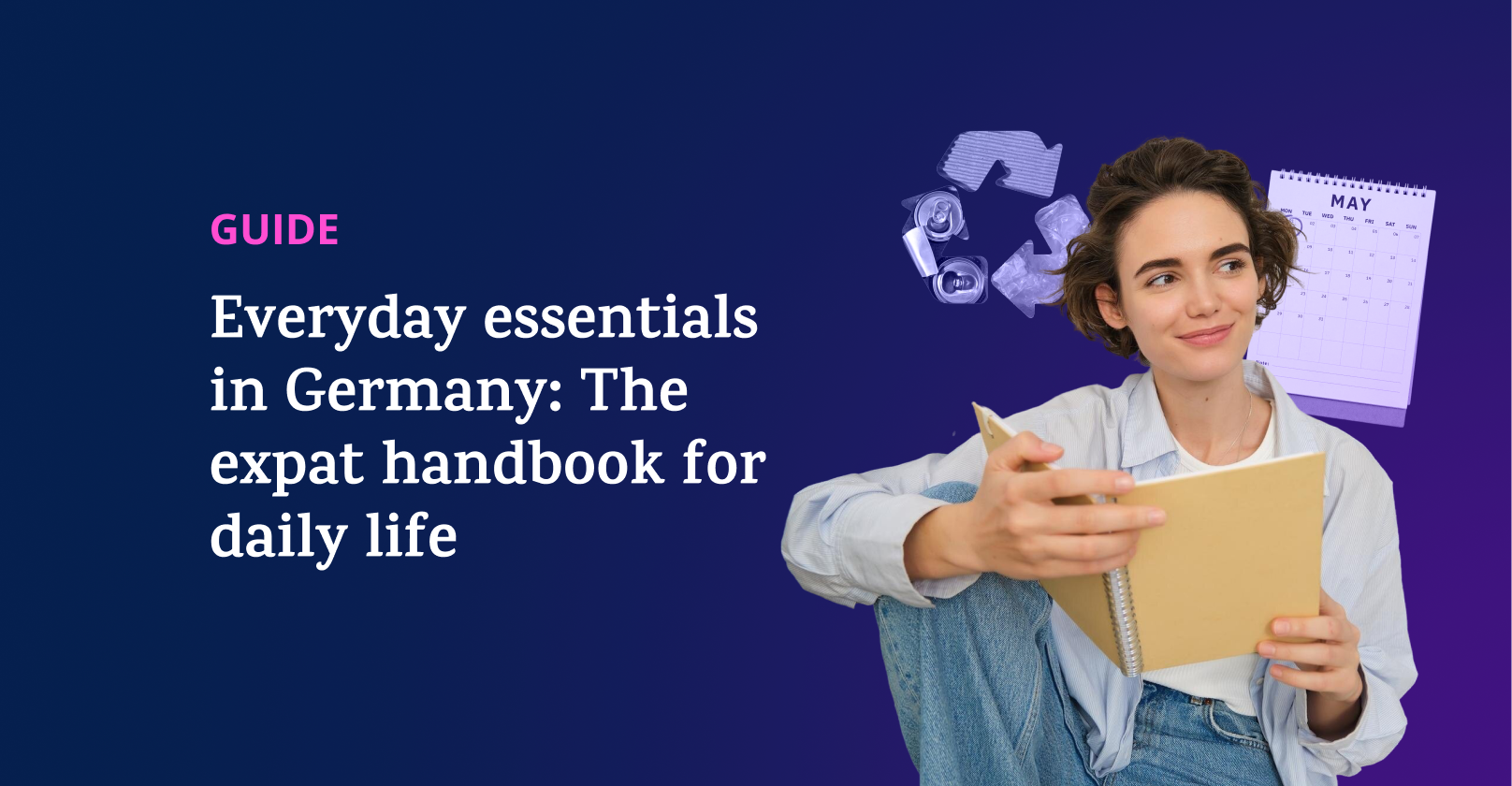Mastering German punctuation (‘Deutsche Zeichensetzung’)

But punctuation plays a crucial role in forming sentences in German, adding rhythm, structure and syntactic clarity. A misplaced comma or a forgotten period can change how your message is understood. And while German does share some common ground with English in terms of punctuation rules, there are enough differences to trip up even confident learners.
In this guide, we’ll review the essential punctuation marks used in German. We’ll then discuss how they differ from English and explain how punctuation plays a role when speaking or dictating sentences in German.
- Common German punctuation marks and their usage
- Key differences between English and German punctuation
- Punctuation in German speech and dictation
- Tips for German punctuation
- FAQs
Common German punctuation marks and their usage
Der Punkt (.) – the period
Der Punkt (the period) is a versatile punctuation mark in German and can be used in the following manners and placements:
- to end sentences
- in abbreviations (e.g., z. B. for zum Beispiel)
- in written dates (e.g., 12.05.2025)
- after ordinal numbers (e.g., 3. Platz).
Das Komma (,) – the comma
Das Komma (the comma) is used in lists, after introductory phrases, and to separate main and subordinate clauses. Unlike in English, many comma placements in German are mandatory and not simply for additional syntactic clarity.
Das Semikolon (;) – the semicolon
Das Semikolon (the semicolon) is used to link closely related independent clauses without a conjunction. It also appears in long lists where commas alone would be confusing.
Der Doppelpunkt (:) – the colon
Der Doppelpunkt (the colon) introduces explanations, examples, lists or direct speech.

Learn German with Lingoda
How it works

Das Fragezeichen (?) – the question mark
Das Fragezeichen (the question mark) goes at the end of direct questions.
Das Ausrufezeichen (!) – the exclamation mark
Das Ausrufezeichen (the exclamation mark) is used for emphasis, whether you’re issuing a command or warning, expressing a strong emotion or even extending an enthusiastic greeting.
Die Anführungszeichen („ “) – quotation marks
Die Anführungszeichen (the quotation marks) are used to indicate direct speech or quotations. The German quotation mark style is „first below, then above“ rather than the “up and up” style used in English.
Der Apostroph (') – the apostrophe
Der Apostroph (the apostrophe) is used in contractions and to show possession — but be careful. Many Germans overuse it, a habit known as the Deppenapostroph (“fool’s apostrophe”). Don’t be that person.
Die Auslassungspunkte (…) – the ellipsis points
Die Auslassungspunkte (the ellipsis points) indicate something left unsaid, a pause or an incomplete thought. Use it with restraint — it’s more subtle than dramatic.
Der Bindestrich (-) and der Gedankenstrich (–) – hyphen and dash
Der Bindestrich (the hyphen) connects compound words (e.g., Deutsch-Englisch Wörterbuch). Der Gedankenstrich (the dash) signals an interruption or change in tone — like this.
Die Klammern ( () ) – parentheses
Die Klammern (the parentheses) are used to add extra information or clarifications that don’t quite fit into the main sentence.
Key differences between German and English punctuation
Commas: More rules, less freedom
If English commas are about style, German commas are about law. They’re required in many situations where English allows flexibility — most notably before and after subordinate clauses. So, while in English you could write, “I know that he’s coming,” in German you must write it as: Ich weiß, dass er kommt.
Quotation marks: Different style, same purpose
English uses “straight up” quotation marks. German prefers the „low-high“ format, with the opening mark at the bottom („) and the closing one at the top (“). It may look unfamiliar at first, but it’s standard in books, newspapers and formal writing. For example: „Ich komme gleich“, sagte sie.
Apostrophes: Use with care
German uses apostrophes far less commonly than English. They’re mainly for omissions (wie geht’s?) and rarely for possession. Overusing them is frowned upon — hence the term Deppenapostroph. So, when in doubt, leave it out.
Time and date formats: Punctuated precision
Germans like their schedules precise, and their punctuation reflects that. Time is usually written in the 24-hour format with a colon; for example, you’d write 14:30 instead of 2:30 p.m.. Dates go from small to big: Tag.Monat.Jahr — for example, 12.05.2025. Note the full stops, which differ from the slashes commonly used in English.
Tips for mastering German punctuation
To wrap it up, here are our top five tips for mastering German punctuation efficiently:
1. Learn the comma rules—and stick to them.
German commas aren’t optional. Get comfortable identifying subordinate clauses and learn when commas are required. A good rule of thumb: if there's a dass, weil or wenn in the sentence, a comma probably belongs nearby.
2. Don’t overuse the apostrophe.
It’s tempting to write Peter’s Auto, but resist. In German, possession usually doesn’t need an apostrophe: Peters Auto is correct. Save the apostrophe for actual omissions (e.g. wie geht’s?).
3. Watch your quotation marks.
Get used to the German format: „like this“. Typing them correctly can be tricky, especially on non-German keyboards, so make use of shortcuts or language settings if needed.
4. Practice punctuation aloud.
Try reading texts and inserting spoken punctuation: Komma, Punkt, Fragezeichen. This sharpens your awareness and also preps you to dictate German aloud via dictation or speech recognition tools.
5. Pay attention to date and time formats.
A quick mental check before writing a date or time can prevent confusion. Remember: 12.05.2025 is not December — it’s May.
Common pitfalls to avoid
- Skipping commas in complex sentences
- Adding apostrophes where they don’t belong
- Using English-style punctuation in German texts
- Mixing up date formats (especially in international contexts)
Helpful exercises and resources
- Read German news articles and highlight punctuation usage.
- Rewrite English sentences in German with the correct punctuation.
- Try online punctuation quizzes or grammar checkers.
- Practice with dictation tools to improve spoken punctuation awareness.
Looking for structured guidance, real-time feedback and the chance to apply what you learn in conversations? Lingoda is a great place to start. With native-speaking teachers and classes that challenge you to write as well as speak, you can master die Zeichensetzung in context — not just in theory.
Are semicolons commonly used in German?
No, semicolons are rare in German. When they are used, it’s primarily to connect related main clauses or separate complex list items.
What’s the correct punctuation for abbreviations in German?
Use a period after each abbreviated part, e.g., z. B. (zum Beispiel), u. a. (unter anderem). Don’t skip the spaces.
Why learning German punctuation matters
German punctuation is essential for writing clearly, sounding natural and avoiding misunderstandings. From strict comma rules to date formats and quotation marks, getting it right makes a real difference. It’s especially important for emails, applications and speaking with dictation tools.If you want structured practice, consider Lingoda’s German language classes as a smart way to build confidence and accuracy, with real-time feedback from native speakers. Viel Erfolg! (Good luck!) May your commas land where they’re needed, your apostrophes stay in line and your Punkt always hit the mark.

Learn German with Lingoda
How it works

















